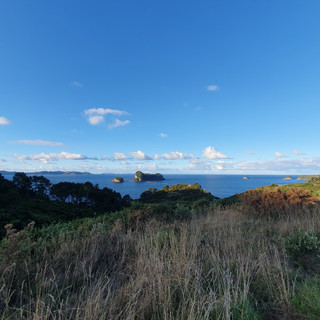New Zealand - the Coromandel
- Declan and Rachel

- Jun 21, 2020
- 3 min read
We have visited New Zealand previously a number of times: Rachel and her thumb in the 1980's; and both of us in a car in 1994, just after Rachel had finished a 6-month secondment in Auckland. Neither of us had ever visited the Coromandel Peninsular, a must do on most visitor's itineries and one of New Zealand's most popular holiday destinations. So what were we missing?
Our first stop was the Kauaeranga valley, camping in the forest next to a stream. So far no beautiful golden beaches, but the following day we continued towards the east coast arriving in Tairua, where a climb to the top of Paku summit gave us breath-taking views out to Shoe Island, Slipper Island and the town of Pauanui. The Coromandel was definitely going to deliver.
We followed the tourists to Hot Water Beach, but the tide was wrong for digging our own hot water pool in the sand, so we continued on to Hahei and took the coastal walk down to Cathedral Cove. We arrived late in the day and were rewarded with a relatively empty, albeit, shady cove.
Aptly named Cook's beach was a favourite - Capt James Cook sailed on the HMS Endeavour into Mercury Bay in 1769 and made anchor.
Continuing north along the coast, we made a planned stop in Kuaotuna to sample the highly recommended pizzas at Luke's Kitchen - we were not disappointed, although the 3km walk back in the pitch dark was an experience. Both Kuaotuna and the whole peninsular out to Otama, Opito and Matapua Bay were beautiful. Pristine, sandy beaches with hardly a soul upon them.
The end of the road on the east coast was another aptly named place, Stoney Bay. Oddly for the peninsular, not a grain of sand in sight. We spent a few days relaxing here, a little fishing, the odd walk and only ducks for company.
As we crossed to the western side of the peninsular, we stopped the night in Coromandel Town and parked up next to an old ambulance, now someone's home from home. The proud owners gave us a ticky-tour of their new acquisition and we were most impressed by their heating - an old, 3kg gas cylinder had been rigged into a wood burning stove, complete with pipes that ensured maximum heat transfer to the inside of the ambulance. Apparently a pine cone was all it took to cook them.
Our tour of the western coast took us as far as Fletcher Bay and Port Jackson. Beautiful coastline with views out to Great Barrier Island. However, we knew we couldn't spend too long isolated from the real world as concerns about Covid-19 were growing. We stopped in Thames on the way back south and it became clear that it was on everyone's mind. With an elderly population, the locals were rightfully getting a little nervous. We knew a lock-down wasn't far away when Rachel had refusals at all the hair stylists that were open in town (at least four of them). I saw a pair of scissors in my future. As a former Boy scout, there hadn't been a Hair Styling Badge.
With muted optimism, we headed out from Thames, with a few extra provisions, some rabbit food, a jigsaw and some seeds. We headed to the Pukorokoro Miranda Shorebird Centre, an important mud-flat teeming with shorebirds and waders. Despite the huge number of birds, our photos do not do them justice.
As we headed towards Tauranga, we stopped at the Karangahake Gorge, taking in a great walk through some of the old mining tunnels along the way. A quick visit to see Whangamata and what was to be our last night in a campsite for a while. At 1pm the following day, we waited by the radio to hear Jacinda Ardern announce that New Zealand was moving immediately to Alert Level 3 (limited movement) and in 48 hours we would move to Alert Level 4. New Zealand was headed for a lock-down.
With food for Milla's rabbit, Boo, seeds for the garden, gloves for gardening and a jigsaw to keep the nieces busy, we crossed back to Raglan and Rachel's brother's house - our bolt-hole for the lock-down.
hkg















































































































Comments